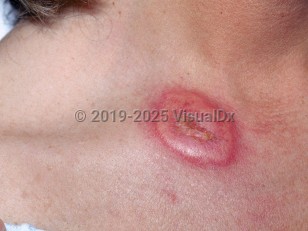Sweet syndrome is classified by etiology:
- Classic idiopathic
- Pregnancy-associated
- Parainflammatory
- Paraneoplastic
- Drug-associated
- Classic (includes all inflammatory causes including infection, inflammatory bowel disease [IBD], and pregnancy)
- Paraneoplastic and drug-related
Although the exact etiology is still unclear, abnormal cytokine expression and atypical neutrophil function are thought to contribute to the pathogenesis. A genetic predisposition may also contribute.
Pathergy is reported in a minority of adult cases but is highly suggestive of this diagnosis. When present, lesions arise or worsen in sites of cutaneous injury, such as needle sticks. Extracutaneous manifestations such as fever, headaches, myalgias, malaise, arthralgias, and ocular inflammation may be seen. Other sites that may rarely be affected include the oral mucosa, liver (hepatitis), kidney (acute renal failure), lungs (pulmonary abscess and infiltrate), heart (pericarditis, aortitis), central nervous system (CNS) (encephalitis), gastrointestinal (GI) tract (ileitis, pancreatitis), lymphatics (lymphadenitis), musculoskeletal (myositis), and bones (sterile osteomyelitis). Hypotension and tachycardia are rare but can occur as a result of systemic inflammation.
Neutrophilic dermatosis of the dorsal hands is considered by many to represent a localized form of Sweet syndrome. Hematologic malignancies and IBD are the most common associations with this subtype. Facial neutrophilic dermatosis is also regarded by some authors as a localized form of Sweet syndrome. It has been described as "crusty pyoderma gangrenosum," and some cases are associated with IBD.
Necrotizing neutrophilic dermatosis describes a subset of patients with severe Sweet syndrome or pyoderma gangrenosum who develop, in addition to their cutaneous disease, fever, leukocytosis (or a leukemoid reaction), and features of shock. Skin pain is a prominent symptom. Additionally, soft tissues underlying areas of skin involvement may be affected with neutrophilic infiltrates and necrosis.
Sweet syndrome typically responds rapidly to systemic corticosteroids, but recurrences can be seen in up to one-half of affected individuals. A minority of pregnancy-associated cases may recur with a subsequent pregnancy.



